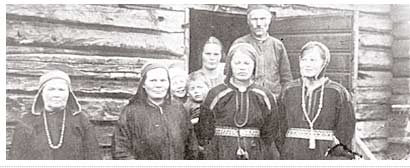|
|
The Inari Sámi costume is decorated similar to the former Norwegian Varanger Fjord and Vuotso in Sodankylä Sámi costumes. In their travels the Sámis have taken their own culture along with them to the different parts of the Sámi region. Influences in the dressing tradition have been mutual. Inari Sámis have moved to Norway which has also been an important trading partner.
The Inari Sámi costume is still the only costume used in the eastern Inari area. The kind of decoration is either that of the wearer’s family or according to his/her own wishes, as is the custom in the Lake Inari region. Due to the differences in the local characteristics inherent in the costumes and in the costume culture the different areas have developed their own style of costume décor.
The use of the Sámi costume has never been interrupted. The costume has previously been used as day-to-day clothing, but the purpose of its use in the present has changed. The Inari folk costume has become a versatile festive and official suit which can just as well be used as work apparel. The costume is a time-honored, traditional and living folk costume that has developed from generation to generation. Along with the language, the Sámi costume makes up an important part of the Inari Sámi identity.
The Colors and Materials
The background of the Inari Sámi women’s and men’s traditional costume is black or dark-blue with red, yellow and green used in the décor.
The women’s summer festive dress is made of cotton or some other suitable material. A shoulder scarf and jewelry for women and a scarf to be worn inside the collar for men complete and compliment the costume.
The peski, or reindeer fur coat, is a winter garment, but snowmobile suits have replaced the traditional, daily use of the peski. A “lukka”, or shoulder covering, made of felt or coarse woolen cloth (frieze), can be worn with the peski. One can also use on the shoulders a woolen scarf which protects the neck and also makes a warm belt worn around the waist.
The lukka can also be used as a shoulder covering with the men’s costume. A woman uses, when needed, a large woolen scarf over the shoulders of her peski or dress. The upper part of the men’s leather leggings is decorated but the upper part of the women’s leggings is hidden under her dress, so they are left undecorated. A man also wears tanned leather trousers the thigh portions of which are made of reindeer leg skins.
Fur boots are winter footwear made by sewing together reindeer leg skins which are laced with paulas (woven cloth bands); laced shoes are also in general use. A “Kallokas” is a shoe made by sewing together leather from the head of a reindeer and the legs. Mittens are also made from reindeer leg skins. Mittens for daily or work use are not decorated. Festive mittens are decorated on the seams and at the wrist opening. Summer shoes are made from tanned cow leather or reindeer hides impregnated with a tar-grease mixture, depending on the use intended. Tanned hide shoes are usually paula shoes, i.e. laced with paulas.
Other Clothing
Shoe laces and belts are woven on a lease loom. Women and men
have their own pattern designs. The pattern design of womens’ paulas
are unsymmetrical and the men’s symmetrical. The patterns on belts
differ in width; the women’s belt is narrower than the men’s.
Men also use leather belts.
A woman’s headdress is a cap made from the skin of a calf or leg. The cap is decorated with felt tassels. A summer hat is made of red felt. A man’s winter headdress is the four-winds cap which has a fur or felt decoration wrapped around the head. The winter cap also is stuffed with down or other suitable material. The summer cap is sewn like the winter cap but without furs.
Mittens knitted from woollen yarn are a part of the
whole winter costume. The patterns of the décor on women’s
and men’s mittens differ from each other. The décor of the
women’s mittens was knitted onto the back, wrist and thumb, while
men’s mittens are decorated only on the wrist.
Ella Sarre
|
|
| Reindeer hide shoes and various hem decorations. |
|
| Artisan Ella Sarre and the back side of a simply decorated traditional men’s costume. |
|


![]()

